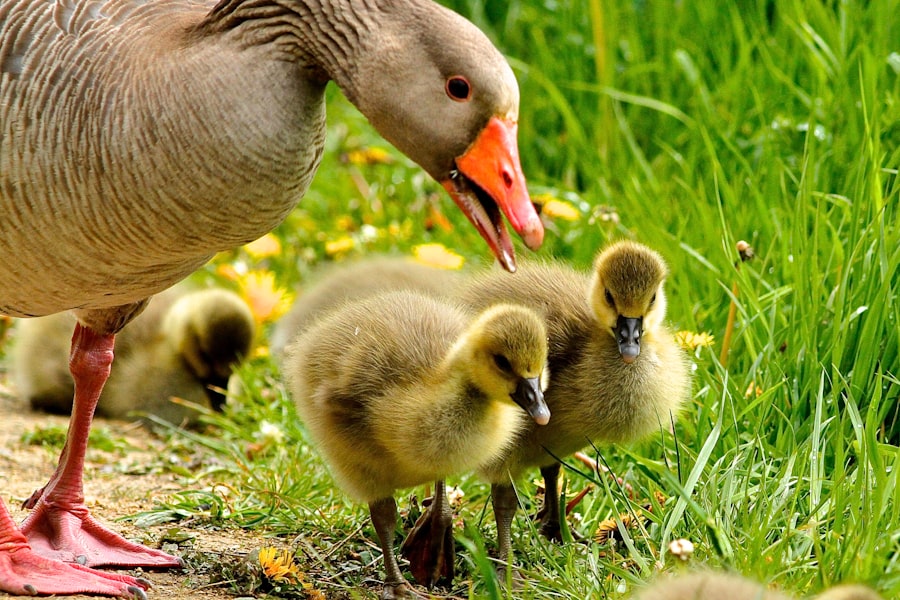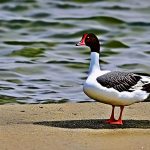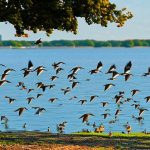Hawaiian geese, also known as nene, are a unique and important species native to the Hawaiian Islands. They are the state bird of Hawaii and hold a special place in Hawaiian culture and folklore. Nene are medium-sized geese, with a distinctive appearance characterized by their brownish-gray plumage, black face, and white cheek patches. They have adapted to the volcanic terrain of the islands and can be found in a variety of habitats, including grasslands, shrublands, and coastal areas.
The nene is not only important culturally but also plays a crucial role in the ecosystem of Hawaii. As herbivores, they help maintain the balance of plant populations by grazing on grasses and other vegetation. They also serve as seed dispersers, helping to spread plant species across the islands. Additionally, nene are an indicator species, meaning their presence or absence can indicate the overall health of an ecosystem. Therefore, protecting nene populations is essential for maintaining the biodiversity and ecological integrity of Hawaii.
Key Takeaways
- Hawaiian geese are a unique and endangered species that play an important role in the ecosystem of Hawaii.
- Habitat loss, predation, and disease are major threats facing Hawaiian geese, making conservation efforts crucial.
- Habitat management strategies must balance the needs of humans and wildlife to protect Hawaiian geese.
- Captive breeding and reintroduction programs are important for restoring Hawaiian goose populations in the wild.
- Monitoring and researching Hawaiian geese is essential for understanding their behavior and health to better protect them.
Understanding the Threats Facing Hawaiian Geese: Habitat Loss, Predation, and Disease
Habitat loss is one of the primary threats facing nene populations. The rapid development of Hawaii for human settlement and agriculture has resulted in the destruction and fragmentation of their natural habitat. Wetlands have been drained for agriculture, and grasslands have been converted into urban areas. This loss of habitat has led to a decline in suitable nesting sites and food sources for nene.
Predation by introduced predators is another significant threat to nene populations. The introduction of non-native species such as rats, mongooses, and feral cats has resulted in increased predation on nene eggs and chicks. These predators have no natural predators in Hawaii and have thrived in the absence of competition or control measures.
Disease is also a major concern for nene populations. Avian diseases such as avian influenza and avian botulism have been known to affect nene populations, leading to significant declines in some areas. These diseases can spread rapidly among bird populations and can have devastating effects on already vulnerable species like the nene.
The Importance of Conservation Efforts for Hawaiian Geese: Protecting a Unique and Endangered Species
The nene is currently listed as an endangered species, with a population estimated to be around 2,500 individuals. The decline in nene populations has raised concerns about the long-term survival of this unique species. Preserving biodiversity is crucial for maintaining healthy ecosystems, and the loss of any species can have far-reaching consequences.
Conservation efforts play a vital role in protecting nene populations and ensuring their survival. These efforts involve habitat restoration and protection, captive breeding and reintroduction programs, monitoring and research, community engagement, and addressing human-wildlife conflicts. By implementing these strategies, conservationists aim to increase nene populations, improve their habitat, and reduce threats to their survival.
Habitat Management Strategies for Hawaiian Geese: Balancing Human Needs with Wildlife Preservation
Habitat management is a critical component of nene conservation efforts. It involves restoring and protecting the natural habitats of nene to ensure they have suitable nesting sites and food sources. This can include removing invasive plant species, restoring wetlands, and creating protected areas where nene can thrive.
However, balancing human needs with wildlife preservation can be challenging. Hawaii is a heavily populated area with limited land resources. The demand for housing, agriculture, and infrastructure often conflicts with the need to protect wildlife habitats. Finding ways to accommodate both human development and wildlife preservation is essential for the long-term survival of nene populations.
Captive Breeding and Reintroduction Programs for Hawaiian Geese: Restoring Populations in the Wild
Captive breeding and reintroduction programs have been successful in restoring nene populations in the wild. These programs involve breeding nene in captivity and then releasing them into suitable habitats. This helps to increase the number of individuals in the population and improve genetic diversity, which is crucial for the long-term survival of the species.
Captive breeding programs also serve as a safeguard against catastrophic events such as disease outbreaks or natural disasters. By maintaining a captive population, conservationists can ensure that there is a reserve of individuals that can be reintroduced into the wild if necessary.
Monitoring and Researching Hawaiian Geese: Understanding their Behavior and Health to Better Protect Them

Monitoring and researching nene populations are essential for understanding their behavior, health, and population dynamics. This information helps conservationists make informed decisions about habitat management, captive breeding programs, and other conservation strategies.
Monitoring efforts involve tracking individual birds, conducting population surveys, and collecting data on nesting success, survival rates, and habitat use. Research focuses on studying nene behavior, migration patterns, and disease prevalence. By gaining a better understanding of nene biology and ecology, conservationists can develop more effective strategies for protecting this endangered species.
The Role of Community Engagement in Hawaiian Goose Conservation: Educating and Involving Local Stakeholders
Community engagement is crucial for the success of nene conservation efforts. Local stakeholders, including residents, landowners, and businesses, play a vital role in protecting nene populations and their habitats. Educating the community about the importance of nene conservation and involving them in conservation activities can help foster a sense of ownership and responsibility.
Community engagement can take many forms, including educational programs, volunteer opportunities, and partnerships with local organizations. By working together with the community, conservationists can create a network of support for nene conservation efforts and ensure the long-term survival of this unique species.
Addressing Human-Wildlife Conflicts: Minimizing Negative Interactions between People and Hawaiian Geese
Human-wildlife conflicts involving nene can arise when their habitat overlaps with human settlements or agricultural areas. Nene may damage crops or gardens, and their presence can sometimes pose a safety risk to humans. Finding ways to minimize these negative interactions is essential for promoting coexistence between people and nene.
Strategies for addressing human-wildlife conflicts include implementing deterrents such as fencing or scare devices to keep nene away from sensitive areas. Public education campaigns can also help raise awareness about the importance of not feeding or disturbing nene and providing guidance on how to safely coexist with them.
The Importance of International Cooperation in Hawaiian Goose Conservation: Working Together to Protect a Global Treasure
International cooperation is crucial for the conservation of nene and other endangered species. The Hawaiian Islands are a global treasure, and the unique biodiversity found there is of global significance. Protecting nene populations requires collaboration between local, national, and international organizations, governments, and stakeholders.
International partnerships can provide funding, technical expertise, and resources to support nene conservation efforts. They can also help raise awareness about the importance of protecting nene and promote sustainable tourism practices that minimize negative impacts on the species and its habitat.
The Future of Hawaiian Geese and the Importance of Continued Conservation Efforts
The future of nene populations depends on continued conservation efforts. While progress has been made in restoring their populations, the challenges they face are ongoing. Habitat loss, predation, disease, and human-wildlife conflicts continue to threaten nene populations.
However, by implementing habitat management strategies, captive breeding programs, monitoring and research efforts, community engagement initiatives, and addressing human-wildlife conflicts, we can ensure the long-term survival of this unique species. International cooperation is also essential for protecting nene populations and preserving the biodiversity of the Hawaiian Islands.
By working together, we can protect the nene and ensure that future generations can continue to appreciate and enjoy this iconic species. The nene is not only a symbol of Hawaii but also a symbol of the importance of conservation and the need to protect our natural heritage.
If you’re interested in learning more about keeping Hawaiian geese, also known as nene, you might find this article on Poultry Wizard quite helpful. It discusses the importance of providing a suitable coop for your chickens and offers tips on how to convert a shed into a chicken coop. Check it out here: https://poultrywizard.com/keeping-chickens/convert-shed-to-chicken-coop/.
FAQs
What are Hawaiian geese?
Hawaiian geese, also known as nene, are a species of goose that is endemic to the Hawaiian Islands. They are the state bird of Hawaii and are considered endangered.
Why is it important to keep Hawaiian geese?
Hawaiian geese are an important part of Hawaii’s ecosystem and culture. They help to spread seeds and control invasive plant species. Additionally, they are a symbol of Hawaiian heritage and are important to the state’s tourism industry.
What are some threats to Hawaiian geese?
Hawaiian geese face a number of threats, including habitat loss, predation by introduced species, and disease. They are also at risk of being hit by cars and other vehicles.
What can be done to protect Hawaiian geese?
There are a number of measures that can be taken to protect Hawaiian geese, including habitat restoration, predator control, and disease monitoring. Additionally, people can help by not feeding or harassing the geese, and by driving carefully in areas where they are known to be present.
Are there any laws protecting Hawaiian geese?
Yes, Hawaiian geese are protected under both state and federal law. It is illegal to harm, harass, or kill them, and there are fines and other penalties for violating these laws.
Meet Walter, the feathered-friend fanatic of Florida! Nestled in the sunshine state, Walter struts through life with his feathered companions, clucking his way to happiness. With a coop that’s fancier than a five-star hotel, he’s the Don Juan of the chicken world. When he’s not teaching his hens to do the cha-cha, you’ll find him in a heated debate with his prized rooster, Sir Clucks-a-Lot. Walter’s poultry passion is no yolk; he’s the sunny-side-up guy you never knew you needed in your flock of friends!







